Another data manipulation affair in Poland, already a third case on my site. First one was a grand scandal in biomedicine reported to me by no less than three independent whistleblowers, and now, after the Gregory Franklin farce in Poznan it’s again plant sciences, this time in Wroclaw. A total train wreck of a paper was recently discussed on PubPeer, by a certain reader of my site with a keen interest in plant sciences. It stemmed from the Institute of Experimental Biology at the University of Wroclaw in Poland, where its first author, Dr Magdalena Migocka is apparently a shooting star of plant sciences. She won her first prestigious research grant in 2010, just 3 years after completing PhD, and has been publishing in respected plant science journals ever since. Now questions about the secret to Migocka’s remarkable productivity arise. The PubPeer disputed paper, not even 4 years old, proved such a little total rascal, that Smut Clyde commented on Twitter:
“Figure 6 needs to sit in the corner and think about what it did wrong”
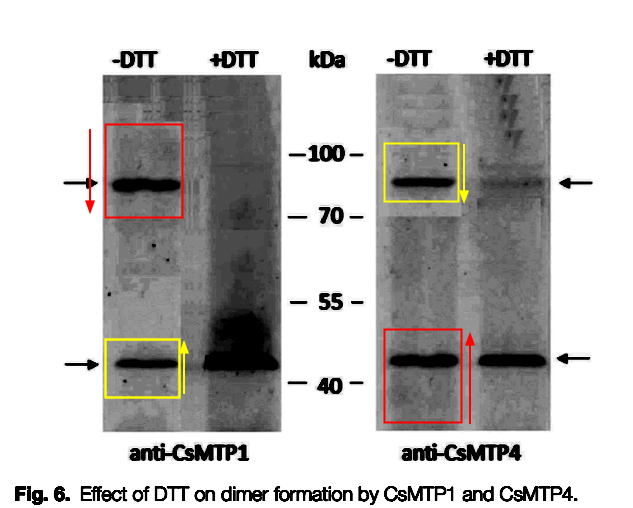
It certainly should. This is the paper where Figure 6 appeared:
Magdalena Migocka , Anna Kosieradzka , Anna Papierniak , Ewa Maciaszczyk-Dziubinska , Ewelina Posyniak , Arnold Garbiec , Sophie Filleur
Two metal-tolerance proteins, MTP1 and MTP4, are involved in Zn homeostasis and Cd sequestration in cucumber cells
Journal of Experimental Botany (2015) doi: 10.1093/jxb/eru459
Obviously the Figure 6 was not left alone to fight for itself. It was assisted by the boldly fraudulent Figure 5, and you will learn later how boldly fraudulent it really was:
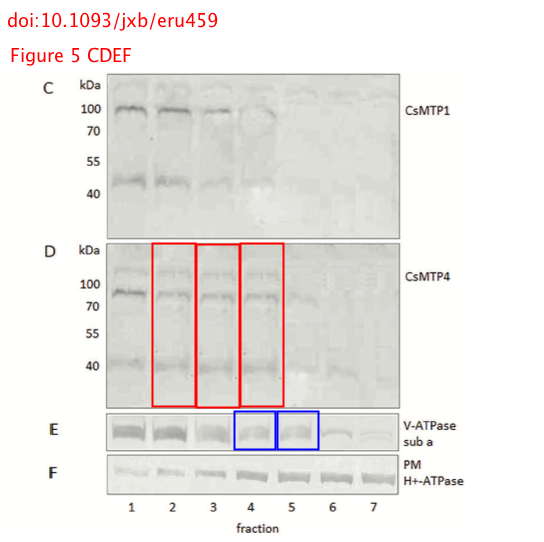
And its other friends, among them Figure 9C and Figure 2A:
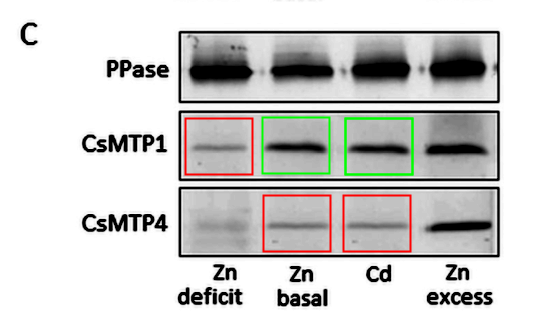
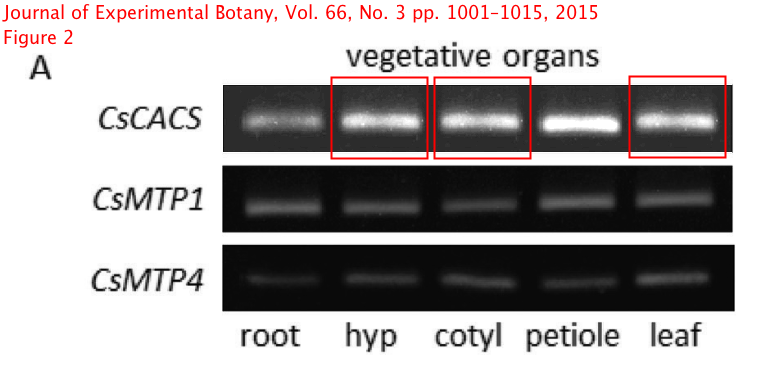
One more figure tagged along, cowardly hiding behind reasonable deniability of intent with its duplicated cell colonies:
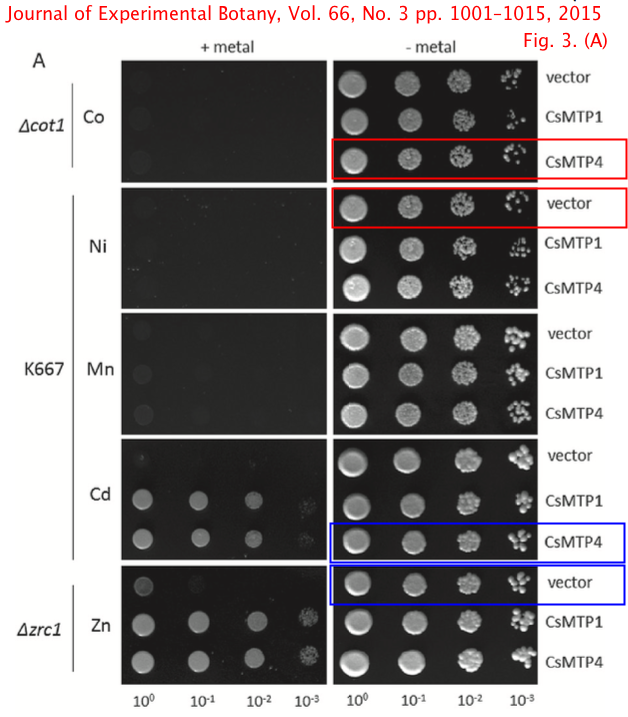
Migocka replied on PubPeer less than 3 hours after criticisms were posted:
“Thank you for your comments. They are very valuable. When you work in a team it is sometimes difficult to control all the results obtained from each co-author. The confusion regarding spot-test is related with control plates. As we usually grow a set of different strains on one control plate in rows close to each other (we use the whole plate) and they look pretty similar it is easy to make mistake while cutting out a few rows for the final picture. However, the original photographs for these experiments show that all the strains grew actually well in controls.
As for the data from Western blots and organ expression analysis, they were all performed by our PhD student, and the biggest problem with them was the very low quality due to weak signals. Hence the author tried to increase the exposure and contrast and select the results that had the strongest signal. When we analyzed the raw data, they confirm the results presented in this work, however the students admits that she cut some bands from different membranes to obtain the best data in one final Figure. The student claims the results are reliable. Nevertheless, we don’t practice this kind of Figure preparation yet.”
See, a scientist shows determination, acts swiftly to interrogate a student, makes her confess, analyses the raw data and establishes that the main findings remain unchanged, all in the matter of two and a half hours. There was however another problematic paper by Dr Migocka, where such figure preparation was practised even two years later.
M. Migocka , A. Papierniak , A. Rajsz
Cucumber PDR8/ABCG36 and PDR12/ABCG40 plasma membrane proteins and their up-regulation under abiotic stresses
Biologia Plantarum (2017) doi: 10.1007/s10535-016-0679-2


Migocka announced:
“Thank you very much for this comment, I will try to clarify this situation with the author of the image.”
Expect more student confessions.
The last author of the first paper, Migocka et al 2015, is Sophie Filleur, tenured scientist at the CNRS Institute for Integrative Cell Biology in Paris, France. Yet the corresponding author is Migocka, all other coauthors come from Wroclaw. The PI of the lab where Filleur works wrote to me:
“The publication contains alarming data manipulation. Our team hosted the first author/corresponding author on the publication to perform the experiment presented on Fig 5A and 5B (confocal microscopy) under the supervision of Sophie Filleur. All the other experiments were performed in the corresponding author’s university under the corresponding author’s supervision. I discussed the matter with Sophie Filleur. She admitted that she should have checked more carefully all the figures of the paper before publication.
We have immediately contacted the corresponding author asking her to retract the publication.”
Filleur meanwhile had to check her own figures. Same reader of my site noticed that a paper Robert et al Plant Mol Biology 2012 which she coauthored with the research integrity expert Laurence Drouard, director of CNRS IBMP in Strasbourg, contained patchwork figures:
Right after her superior replied to me, Filleur posted raw data on PubPeer. Indeed, the figures were assembled from bits and pieces, while the editors, reviewers and readers were left believing they were looking at intact gels.
Meanwhile in Poland things were moving swiftly. Migocka’s Head of Department (and her former MSc and PhD thesis advisor!) Grazyna Klobus announced to me that she supports Filleur’s request for retraction:
“I have also contacted with dr Migocka and she informed me that is going to retract both papers immediately.”
There might be more trouble. This was Migocka’s first last author paper, and also that one contains duplicated data. A gel was reused for unrelated samples:
Kabała K1, Janicka-Russak M, Reda M, Migocka M.
Transcriptional regulation of the V-ATPase subunit c and V-PPase isoforms in Cucumis sativus under heavy metal stress.
Physiol Plant. (2014) doi: 10.1111/ppl.12064.

And this fabricated gel was published by Migocka in a common paper with her thesis mentor and now head of department Klobus:
Migocka M1, Papierniak A, Kosatka E, Klobus G.
Comparative study of the active cadmium efflux systems operating at the plasma membrane and tonoplast of cucumber root cells.
J Exp Bot. (2011) doi: 10.1093/jxb/err180.

Maybe you have a deja-vu when looking at this fabricated Figure 1C in Migocka et al 2011? This is because the bands re-appeared in the Figure 5 of the disastrous Migocka et al 2015 paper in same Journal of Experimental Botany, discussed in the beginning. Turned out, Figure 5 was even faker than we originally thought! It also contains elements from the Figure 4 from yet another paper, again in same journal: Migocka et al 2014, where Filleur is incidentally also last author.
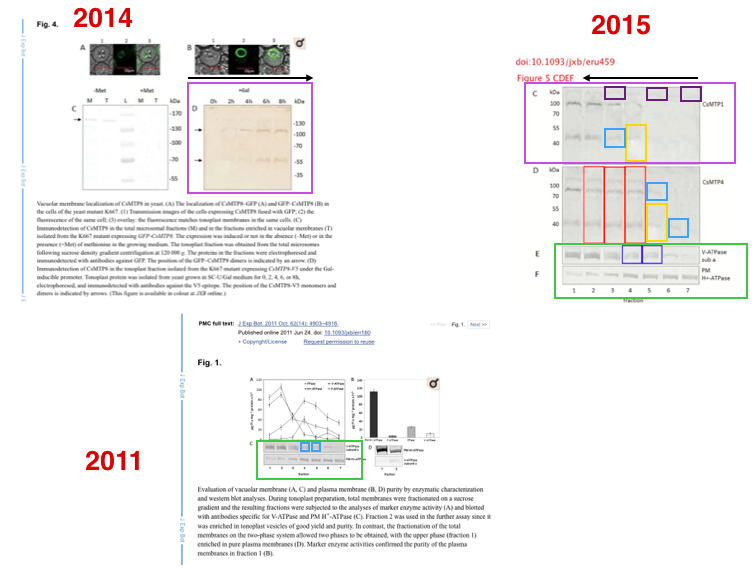
More student interrogation, presumably. Dr Migocka must also determine who faked the gel in the Figure 3 of this paper:
Migocka M, Papierniak A, Kosieradzka A, Posyniak E, Maciaszczyk-Dziubinska E, Biskup R, Garbiec A, Marchewka T
Cucumber metal tolerance protein CsMTP9 is a plasma membrane H⁺-coupled antiporter involved in the Mn²⁺ and Cd²⁺ efflux from root cells.
The Plant Journal (2015) doi: 10.1111/tpj.13056
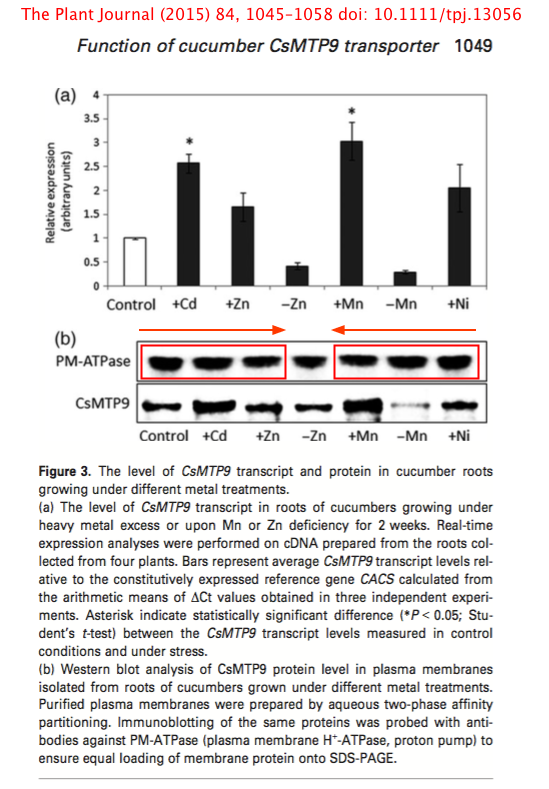
In the same year, another paper with fabricated data:
Migocka M, Papierniak A, Maciaszczyk-Dziubinska E, Posyniak E, Kosieradzka A.
Molecular and biochemical properties of two P1B2-ATPases, CsHMA3 and CsHMA4, from cucumber.
Plant Cell Environ. (2015) doi: 10.1111/pce.12447
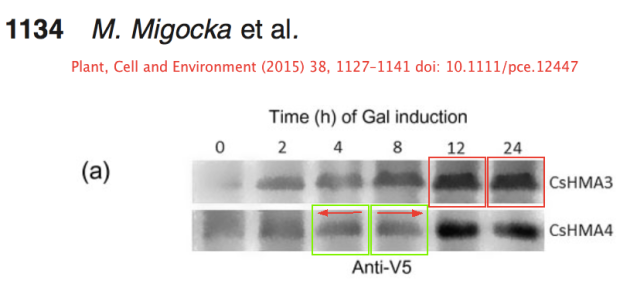
2015 was indeed very productive. Someone felt very safe. This appeared in Journal of Biological Chemistry, which is very tough on data manipulation:
Migocka M, Posyniak E, Maciaszczyk-Dziubinska E, Papierniak A, Kosieradzaka A.
Functional and Biochemical Characterization of Cucumber Genes Encoding Two Copper ATPases CsHMA5.1 and CsHMA5.2.
J Biol Chem. (2015) doi: 10.1074/jbc.M114.618355
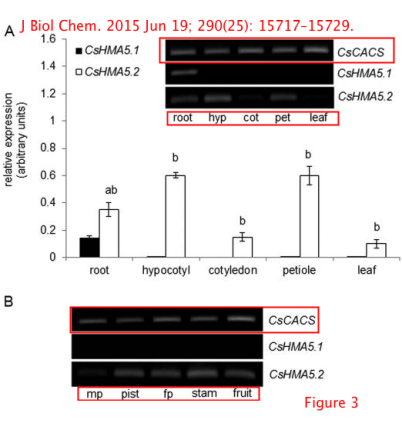
A gel was reused for different samples, with brightness slightly changed, likely to hide similarity. And what happened to Figure 4? JBC has retracted papers for less…

My reader, who assembled all this material decided to make the experience interactive. He invites you to study the Figure 5 of Migocka et al JBC 2015 paper:
“Figure 5A is just incredible, I’m not annotating it, I’d rather leave it for your readers to find out how creative Migocka can be with blots. I can’t even imagine what she’s up to with bar plots”.
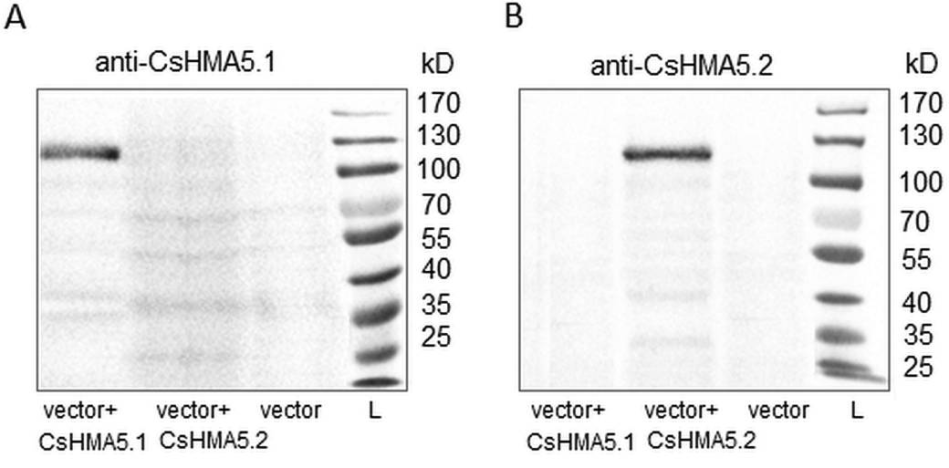
But maybe that was all in the past, as Dr Migocka said? All good and honest, now that a full professorship is within reach? How sure is Adjunct faculty member Dr Migocka that her students “don’t practice this kind of Figure preparation” anymore? This was namely published just this year:

Obviously some gel bands from an unrelated experiment were reused in a different paper for different samples. The gel originally appeared in Migocka et al Plant Journal 2018, though what samples those originally was showing is anyone’s guess now. After all, if it’s the same antibody, and all bands look similar, does it really matter which samples the gel originally contained? Why wasting reagents on experiments one just knows the result of anyway? This is the 2019 paper which adopted the 2018 figure:
Migocka M, Maciaszczyk-Dziubinska E, Malas K, Posyniak E, Garbiec A.
Metal tolerance protein MTP6 affects mitochondrial iron and manganese homeostasis in cucumber.
J Exp Bot. (2019) doi: 10.1093/jxb/ery342.
There is also this remarkably similar photograph of a protoplast, which also made its first appearance in Migocka et al 2018:
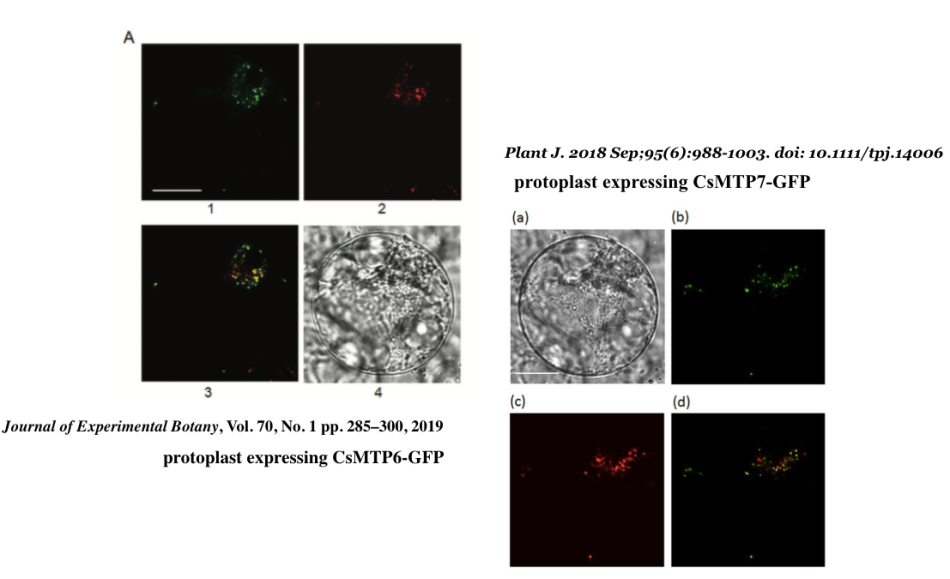
Lots of work for teh journal editors, especially for the society-published Journal of Experimental Botany, and even more work for Inspector Migocka investigating her student saboteurs.

Maybe department head Professor Klobus should outsource the investigation of her mentee Migocka, to unbiased experts, ideally from abroad? Before more students are made to confess everything?

Donate!
If you are interested to support my work, you can leave here a small tip of $5. Or several of small tips, just increase the amount as you like (2x=€10; 5x=€25). Your generous patronage of my journalism will be most appreciated!
€5.00


I found some more issues with J Exp Bot. 2014 Oct; 65(18): 5367–5384.
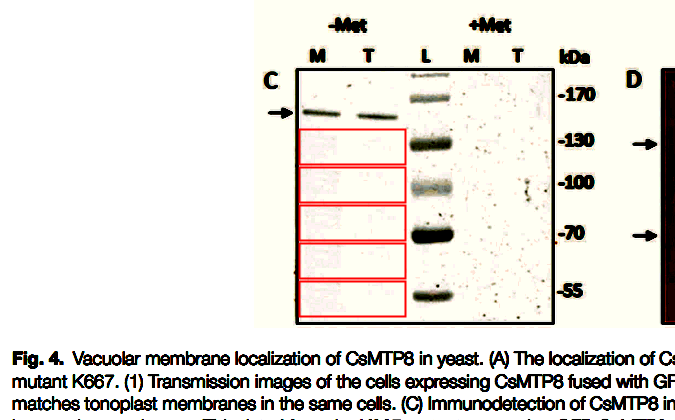
See : https://pubpeer.com/publications/FBE89BB604B0F340C825DDA717CC62#3
LikeLike
More issues can be seen in 2019 JExBot that mis-recycles data from 2018 Plant Journal.
See: https://pubpeer.com/publications/B9B7C78E6B3BBF08247333EFD22883#3
LikeLike
By my count her group of papers on PubPeer now number 10. As the institutions are apparently moving swiftly we may see faster than normal retractions or corrections to the papers.
LikeLike
To have one sloppy student is unfortunate, to have two begins to look like carelessness – I mean downright fraud.
LikeLike
Sloppy student…probably because the person running the lab and getting the grants did absolutely nothing to train people properly. Thats how labs work these days…the “advisor” gets angry when they are expected to actually help someone in the lab. So much for learning in academia
LikeLike
Getting angry is nothing to do with Photoshop fabrication. There are excellent supervisors/advisors, who are not sitting on the shoulders of their postdocs, and the lab still works. Doing PhD or postdoc is not the same as doing a BSc or MSc. So, a PhD student/postdoc is expected to have the skill to do a WB without standing the boss behind him/her. So do not blame the advisor if the WB does not work and or you chose Photoshop to help you out. But in my opinion, if a WB is Photoshopped, the boss knows it. Period.
LikeLike
Yes and…no. Having been nearly caught out myself recently (and two other eagle eyed colleagues similar fooled by the name ;data’) I have to agree with @owlbert. We do not have photoshop. But nonetheless a PhD student did make up some blots, something that I did not think would happen in the group. I only discovered the issue because I used a different OS to print, which showed up one fabrication very clearly.
So it will not always be the PI, but in the case of serial fraud, where the PI is also defensive and shifts the blame, then the PI is to blame.
Even in the case in my lab, I do lay part of the blame on my own shoulders, though I do not see how the problem could have been avoided. We cover fraud in lab meetings, data are sacrosanct and all experience in the lab are deemed to ‘work’ since we learn from them.
LikeLike
Did you suggest that student to continue in a more specialized lab? Like that of Bulfone-Paus nearby, in Manchester?
LikeLike
I found yet another obvious band duplication.

See : https://pubpeer.com/publications/FBE89BB604B0F340C825DDA717CC62
LikeLike
I marked some of the mirroring axis and dupliicated parts, but I ran out of colors.
LikeLike
For God’s sake! Where was the autor’s superior and publication’s co-authors at that time, doesn’t anyone read it? I don’t even mention the reviewers! Publish or perish, huh?! The whole institute had a huge push to publish at all costs, and now such surprise! One good thing we’ve GUILTY of this FRAUD, the rest of you can sleep peacefully, right?? No, not so fast there – the truth is, you all have dirty hands, each and every one of you! You know what I’m talking about, don’t pretend it’s different. Success has many fathers, fraud is an orphan…
LikeLike
Excuse me, but I had nothing to do this. I am willing to sacrifice my career on the cross of truth, but too may people others (faculty, for example) are not.
I think we need to go back to a time when science was only done by the independently wealthy.
LikeLike
The Journal of Experimental Botany is currently investigating the image issues that have been brought to our attention in accordance with COPE guidelines and will respond in due course. The journal does not allow composite or altered gels/blots/exposures unless the changes are made explicit and reasons for changes are made clear and described in the legend/paper.
LikeLike
By the Power of Grayskull! Let Grażyna speak, she knows everything and is always right!
LikeLike
Widzę, że ktoś z otoczenia 😁
LikeLike
So only the last paper wasn’t co-authored by Anna Papierniak. Migocka and Papierniak worked together on all these papers. Do we know which one of them (or maybe both?) was faking the data?
LikeLike
I hope we will able to find it in two-three weeks – Dean od the Faculty decided to form a small but formal “committee to investigate the matter”. As I could see there were much more persons involved in preparation of more than one manuscript (5persons are co-authors at least 4 papers). Thus, let’s not speculate now who prepared those Figures. Obviously, the corresponding author takes a full responsibility for everything in the manuscript.
LikeLike
The 2-3 weeks timeframe is too optimistic. I have myself noticed some image irregularities in some articles and notified the authors and the editorial boards. Authors never replied. Editorial boards replied, ensuring me about a proper investigation. And months or years have passed without hearing form them again. These kind of assuring emails are the new rejection letters. This message is generated automatically, please do not reply…….
LikeLike
You know that this “college committee” does not want to explain anything. University of Wroclaw depends only on silencing the case. But I understand that you defend your friend from work. You know well that it has been a secret for a long time, it was a quiet consent.
LikeLike
Prof Dariusz Rakus in 2017 used public research funds to decorate his academic CV with holidays in Paris.
https://www.omicsonline.org/speaker/dariusz-rakus-university-of-wroc-aw-poland/
LikeLike
Just a short comment on the “She won her first prestigious research grant in 2010, just 3 years after completing PhD, and has been publishing in respected plant science journals ever since.” sentence. Iuventus Plus was not really a prestigious grant and aimed at young (below 35 years old) scientists. It jus happenned that polish ministry of science had at that time some money to spend asap and they made this call with minimal requirements – and many young scientists got it. The max. amount was, if I remember correctly, around $50k.
LikeLike
But she has financed some of her suspicious research through the Iuventus Plus grant money. In addition to that, in 2013 she received a Sonata grant with 500,000 PLN, or about $130,000, research money.
LikeLike
The most sad thing is that the University of Wroclaw – does not intend to explain anything. He is currently trying to calm down the matter, “sweep under the carpet”. Unfortunately, people who disagree with this type of practice are brutally silenced….
LikeLike
Dear Leonid Schneider, You are right : I was ask to participate in that Congress having no knowledge about the specific nature of that. Like many much better than me proteomists.
I suppose that it is difficult to find in the Internet that I was not there.
And believe me, the participation in a conference is not especially important in “decoration” of academic CV in biology (maybe in some fields it is important).
Anyway, I understand and support your activity even sometimes it is hard to agree with the form of discussion (and sometimes with overinterpretations).
LikeLike
Dear Dariusz,
I am happy to hear that you did not participate in the OMICS scamference and did not give public money to fraudsters. Sorry about the misunderstanding.
LikeLike
Dear Leonid, No problem. As I wrote I support Your activity and some mistakes can happen if you try to work hard and to do a good job.
LikeLike
When is this horrific person who is pretending to do cancer research put to justice? Why is RECTOR OF THE UNIVERSITY OF WROCŁAW
prof. dr hab. Adam Jezierski
Uniwersytecki 1, room 124
50-137 Wrocław
phone: +48 71 343 68 47, +48 71 375 22 12
e-mail: rektor@uwr.edu.pl
not acting?!
LikeLike
Oh. Fig. 6 is really badly photoshopped. I’d argue it was doctored with MS Paint. What the hell…
LikeLike
I am wondering in how many papers there are manipulated figures because Migocka delivered them. I don’t mean the papers that she is a main author, but all the other where she did contribute. I would be very concerned having her on my co-authors list and would investigate the matter. Asking for a source data would be a good start.
LikeLike
You’re absolutely right! Unfortunately, in my opinion, asking for source data may not be enough. The investigation should be started much earlier, ideally with school essays and school papers. Then we should check again all the student’s midterm that Migocka was teaching. @Darek Rakus, all hope in your special committee, I’m keeping my fingers crossed for you!
LikeLike
Do you maybe know where to look for the outcome of the investigation made by the internal commitee? I am indirectly bound to this unit and I hope they will really solve the situation as it should be solved- to retract papers is the lowest penalty…
LikeLike
Danny, obviously it is. For me, upper lanes 1, 3, 5 are the same. It is also the case for upper lanes 2, 4 and 6
LikeLike
Every citizen, concerned or not, might ask for the information on a basis of “Ustawa o dostępie do informacji publicznej”
https://irsw.pl/zasady-dostepu-informacji-publicznej-specyfice-funkcjonowania-uczelni/
Therefore you are completely legible to ask:
– whether any proceedings were initiated
– what is the current status
– when they are suppose to end
– and many more.
Don’t forget to do it rather in writing, and evoking your rights quoting an appropiate law.
LikeLike
Ah, and the University Rector will be the addressee, unless he points to some one else (but has to do it officialy).
LikeLike
Hey prof Rakus! What about te investigation? We remember and we do not let to forget about the “Migocka Gate”…
LikeLike
Ktosiek, more like Gosiek! Don’t be shy, everyone knows it’s not about better science, but about ruining Magda!
LikeLike
Sooo, there are people claiming that making all this things visible to everyone is ruining somebody? Like someone did it accidentally and is being wrongfully accused for frauding?
At very very least, someone was constantly submiting someone’s else frauding signed with their’s name, taking responsibility for this. It’s (at best cause, the latter case) like big shiny banner ‘I don’t care about quality’. Such person coping with science community ostracism after publishing all this papers? The lowest penatly, I hope.
I don’t see it as ‘ruining’, it’s finally ending astoundingly shameful practice.
LikeLike
@butterflyofchaos
You do? Really?! If this is a real struggle for better science, why not mention the other “Gate”? Let’s take, for instance Klobus Gate (mandatory addition of a supervisor to all articles and sometimes intentionally(sic!) omitting people whose data has been used), Grant Gate (allocating money from received grants to protege staff) and last but not least Paper Gate (obstruction of the publication of articles).
LikeLike
Dear Donie,
you are correct – when investigated, probably every istitution and many people can be associated with some “-gate” scandal.
Nevertheless, mandatory addition as an author might be unethical and is violating publication policy of many journals (where only solid contributions make a person eligible for an authorship); omitting “true” authors for sure is unethical and can be considered IP theft/copyrights infringement; unproper grant money allocation might be misusing of public funds/theft and obstructing publication process might be considered a working ethic/mentor ethic violation – nevertheless, none of these are scientific misconducts.
It doesn’t mean that they are justifiable, but technically shouldnn’t be of concern of a general, scientific audience, as this one is not directly involved nor potentially harmed by such actions. What cannot be said about lying about your data or simply making this data up.
However, if you are aware of actions that you’ve mentioned above, I would advice contacting your university ombudsman or any other proper authority to start a proper investigation as clearly something wrong is hapenning.
LikeLike
You must really like this department!!! 😀 But whatever you say, “Klobus Gate” is well known to me (unfortunately)…
LikeLike
“Klobus Gate” is common in Polish academic community, so it should be called “Academia Gate”. It’s a comforting fact that I have never seen it before abroad. On the contrary, tutors have always provided advice without expecting anything in return. However, I remembered from this department the fact that the results of my research or my notes can “disappeared”. There were no guilty ones… Also sad was the fact that when a research topic became interesting, Klobus would pick it up and redirect it to people whom he favoured. In those days, nepotism and “deals” were the everyday thing and I’m afraid that nothing has changed to this day. And what @donniedarko presented in such an overblown tone is mostly known to me from the beginning of my scientific career. Unfortunately, such situations aren’t as tangible as retouched photo or don’tt so affect “science integrity”, so they are often ignored and will probably be everyday in Poland for many years…
LikeLike